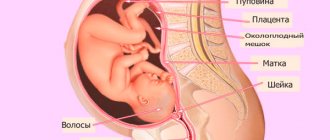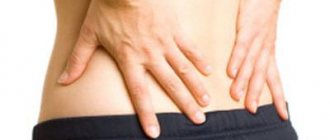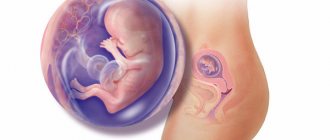What happens at 30 weeks of pregnancy in a woman’s body
The height of the uterine fundus above the navel is about 10 cm, above the womb - from 30. Due to the actively expanding abdomen, stretch marks (stretch marks) form at the 30th week of pregnancy. Also characteristic is their appearance on the mammary glands, which are now actively preparing to produce milk.
At this time, “training contractions” may begin, but usually they appear a little later. Excessive pain or a feeling of “hardness” in the abdomen may be a symptom of premature labor at 30 weeks of pregnancy.
Pregnancy at 30 weeks is accompanied by the appearance of many unpleasant symptoms - heartburn, constipation, and frequent urination. This is a variant of the norm, because there is less and less space for internal organs every day.
What can be seen on an ultrasound
Ultrasound examination allows us to determine developmental pathologies in children even before they are born. Problems may be with the development of internal organs, blood circulation, blood vessels, the brain, or improper fusion of the bones of the body.
It is during an ultrasound that the weight of each fetus, height, and degree of development are most accurately determined. Vascular pathology can be checked using Doppler ultrasound.
In addition to the development of babies, during the study the condition of the placenta, its place of attachment and the possible risk of detachment are determined.
Fetus
At the 30th week of pregnancy, the fetus is actively growing and its weight increases. Now it is the size of a head of cabbage. The baby becomes cramped in the uterus, he takes a forced position, most often this is a cephalic presentation. That is, it is positioned head down - the way it will come out during childbirth.
At this stage, the number of movements is reduced, but the tremors become stronger, even sometimes painful. The baby can rest against the ribs or internal organs, causing significant discomfort to the pregnant woman. The baby opens his eyes, blinks, hiccups, smiles, reacts to light and sound.
Be prepared for both natural birth and caesarean section
The doctor will actually choose the best option for delivery for you. And sometimes, as my doctor told me, women give birth to one naturally, and then the second through a caesarean section.
Don’t worry and don’t program yourself for surgery in advance!
Consult your doctor and take “preparatory” courses before giving birth. And don’t panic in advance - in any case everything will be fine.
Maternal weight and child development
The baby is no longer tiny! The baby's weight at 30 weeks of pregnancy is about 1.5 kg. He is quite capable of independent life, but still poorly regulates body temperature, so he accumulates subcutaneous fat.
Newborns have developed reserves of brown fat, which is several times greater than regular fat in terms of energy. When it breaks down, a lot of heat is generated, which protects the baby from hypothermia. And until the child has accumulated enough “fuel”, it is too early for him to be born.
The nervous system and all sense organs continue to develop. The grooves and convolutions in the brain deepen, new interneuron connections and “bridges” are formed.
In girls, the formation of the vagina has completed and the external genitalia are almost completely formed. In boys, the testicles descend into the scrotum.
Normally, weight gained at 30 weeks of pregnancy should be 8–10 kg. Now the weight should increase by another 300-350 g. The uterus has greatly increased in size and weight, shifting the center of gravity of the body.
Sexual activity and sex
Many women wonder when they can have sex. And is this acceptable at 6 months? With a normal pregnancy, of course, yes you can. Some doctors believe that sex is not recommended after 30 weeks. This depends on a number of indicators, in particular, on the presentation of the child. If he has not yet taken a normal position, it is quite possible to continue sexual activity. Sex should be avoided during oligohydramnios. During a normal pregnancy, the amniotic sac perfectly protects the baby, and the amniotic fluid absorbs all shocks, so sex cannot harm except in pathological conditions. Doctors still recommend abstaining from sex:
- if you are planning to have twins or triplets;
- with uterine tone;
- with a low position of the uterus;
- with bleeding;
- if you have had miscarriages before;
- for infectious lesions that were not treated before pregnancy (venereal).
Feelings at 30 weeks of pregnancy
The baby can no longer tumble around in the amniotic fluid, but the mother clearly feels every movement of the fetus at 30 weeks of pregnancy. Daily counting of movements is useful. There should be at least 24 of them per day, and at least 10 in 6 hours.
Often at the beginning of the third trimester, shortness of breath occurs during physical activity, while lying on your back. This occurs due to the upward displacement of the diaphragm dome - there is now not so much space for the lungs. Sometimes it is very difficult to come to terms with the feeling of lack of air.
Nagging pain in the lower back and pelvic bones gradually increases, but many women are already accustomed to such sensations at 30 weeks of pregnancy and do not pay attention to them.
Digestive problems can be uncomfortable. Due to delayed gastric emptying and compression, heartburn, heaviness and a feeling of nausea may occur. If the symptoms are persistent and severe, the doctor will prescribe medications to improve digestion that are harmless to the baby.
Baby's movements
The baby's movements - their number and strength - during this gestational week have important diagnostic significance. Considering their activity, you can determine the child’s well-being. You can count movements in several ways:
- within an hour, the baby should push at least six times;
- within a six-hour period, the child must make himself known at least 10 times;
- in 12 hours - from 9 am to 9 pm - a woman should feel at least 24 tremors.
This is the average norm and small deviations are quite acceptable. But if the number of movements significantly exceeds or lags behind the indicators, then this must be reported to the gynecologist.
Pain
The most common cause of abdominal pain at 30 weeks of pregnancy is excessive fetal movements. This can happen if the baby is uncomfortable: for example, he was scared by a loud sound. All the mother's experiences are transmitted to the fetus. To calm your baby down, you need to relax and stroke your belly.
Physiological changes also affect a woman’s well-being. A pregnant woman gains about 10 kg by the 30th week. The load on the back increases, causing back pain. A woman may be bothered by nagging pain in the lower back.
Headache is also normal at this time. A pregnant woman cannot take painkillers, so you should get rid of pain at 30 weeks of pregnancy using folk remedies. You need to get enough sleep, walk in the fresh air, relax during the day, and not be nervous. If you have a severe headache, you should lie down, you can massage your head and neck, and apply a cool compress.
It is necessary to learn to distinguish training contractions from the threat of premature birth. If the pain in the lower abdomen is accompanied by bloody or copious liquid transparent discharge, then you need to go to the hospital. This is a sign of premature birth. Training contractions last no more than 2 minutes and are manifested by abdominal tension.
Learn not to obsess over what others think of you.
In fact, this is a very important rule.
For example, during pregnancy, do not be afraid to bother your doctor with your visits or calls if you feel discomfort or are worried for any reason. Or even if you are afraid to take sick leave and sit at work, feeling bad some days, just so that your boss doesn’t get angry.
After all, you want to carry babies, right? Then what difference does it make what a doctor or boss thinks of you?
Rest and treatment are provided to you by the state, and the doctor is simply obliged to help you solve your current problems.
Childbirth
At this stage, there is a possibility of premature birth, despite the fact that it is too early for the baby to be born. Childbirth at 30 weeks of pregnancy guarantees every chance of life: the survival rate at this stage reaches 100%. All organs and systems function normally. The baby's respiratory system is not yet fully formed, but he can breathe on his own. After birth, the child is connected to a special device for “growing up.”
The most common causes of premature birth are polyhydramnios or oligohydramnios, placental abruption, sexually transmitted infections and chronic systemic diseases, poor quality nutrition, smoking or alcohol abuse.
Do not carry heavy objects or do excessive physical activity.
Of course, pregnancy is not a disease. But this does not mean that you can lead your usual lifestyle.
Yes, with a singleton pregnancy this is sometimes possible.
But your body has a double burden, and you have a double responsibility for the lives of your children.
Therefore, discuss with your doctor the question of the limits of physical exercise allowed for you personally, and perhaps eliminate them completely.
You will have time to solve all the tasks of returning your body to its normal shape after giving birth. After all, with twins you will have to run twice as much
Recommendations
Having passed 75% of the way, there is no need to slow down and let everything take its course. It is necessary, as before, to monitor your health and regimen very carefully.
Nutrition
Nutrition at 30 weeks of pregnancy should contain a minimum amount of useless carbohydrates - sweets, baked goods. It is better to replace them with fruit desserts and jellies. The drinking regime is the same - if there is no swelling or high blood pressure, then you need to drink in small portions up to 2 liters of water per day.
It’s better not to drink at night, since high pressure on the bladder can lead to frequent trips to the toilet, and there’s no need for an extra factor causing edema.
Vitamins
Taking vitamins on your own is not allowed, since at the 30th obstetric week, an excess of vitamins is as dangerous as their deficiency. The doctor may prescribe calcium and iron supplements.
Sex at 30 weeks pregnant
During a normal pregnancy, there is no prohibition on intimate relationships. It is important to be careful not to harm the baby.
Physical activity
Walking is still required. The main thing is not to overexert yourself, and not to spend a lot of time outside in the heat or severe frost. Swimming - no restrictions.
If mommy still does not attend childbirth preparation courses, the 30th obstetric week of pregnancy is the time to start classes! Correct breathing techniques and exercises for pregnant women are the main elements of physical activity during this period.
Trimesters
In what position can you sleep during pregnancy, and does the choice of the optimal sleeping position depend on its duration? The answer is clear - it depends, and the longer the period, the more important it is for the expectant mother to think about the safety of the child during the night's rest. Often pregnant women complain: “Everyone says that sleeping on the right side during pregnancy can harm the baby, but I simply cannot sleep any other way.” In fact, everything is far from being so categorical, but for each period, doctors have special recommendations that are best known and followed.
First months
How to sleep better in early pregnancy? Of course, choosing the right and comfortable position at the same time. While the fetus and belly, respectively, are still very small, almost any option in which the expectant mother feels as comfortable as possible is acceptable. In the first trimester of pregnancy, that is, up to 11-12 weeks, there will be no harm to the baby, even if his mother sleeps on her stomach every night. At this time, the uterus is still protected from pressure by the pelvic and pubic bones, and the bladder has to feel the main load.
In the first trimester you can even sleep on your stomach
The only thing that can prevent a woman from sleeping soundly in the early stages of pregnancy is increased sensitivity and even soreness of the breasts, which appears as a result of hormonal changes occurring at this moment in the body of the expectant mother. In addition, even during early pregnancy, doctors recommend gradually learning to sleep on your side or at least in an intermediate position, placing a special pillow behind you, so that in the future, refusing to rest on your back and stomach will be painless.
Second trimester
Due to the good health of the expectant mother and her good sleep, the 2nd trimester is rightfully considered the happiest period of pregnancy, during which the main hormonal storms have already subsided, and the problems of excess weight and back pain have not yet made themselves felt. But now, wondering how to sleep better in the second trimester, she should first of all think about the health and safety of the unborn child, and not about her comfort. At the 15th week of pregnancy, the uterus already feels a lot of pressure, and although the fetus is well protected by adipose tissue and amniotic fluid, sleeping on the stomach at this time is not recommended.
From 24-26 weeks, expectant mothers have to give up resting on their backs - the fetus becomes quite large, which is why the uterus, pressing against the spine, can compress the inferior vena cava. Therefore, pregnant women during this period are recommended to sleep on their left side, sometimes turning to the right, and listen carefully to the movements of the fetus - if the baby is uncomfortable, he can tell the mother about it with kicks.
Third trimester
How is it recommended to sleep in the last weeks before giving birth? This question is not an easy one, because already at 33 weeks of pregnancy, the size of the abdomen significantly complicates the choice of a comfortable position for rest. How can you alleviate the condition of the expectant mother if she is already in her eighth month? At 8 months of pregnancy, doctors recommend sleeping exclusively on the left side to protect the liver from excessive pressure from the fetus. The same rule applies to the ninth: how to sleep in the 9th month of pregnancy, if the stomach has become so large that even turning on the other side is a whole problem? Of course, spending the whole night in one position is quite difficult, but with the help of a special pillow sandwiched between the knees and a cushion placed under the stomach, you can almost completely get rid of the discomfort.
This way you will sleep very comfortably
In addition, if at 35 weeks of pregnancy an abnormal position of the fetus was detected, a suitable sleeping position can correct the situation: with a breech presentation, sleeping is allowed exclusively on the left side, and with a transverse presentation, sleeping on the side where the baby’s head is directed.
Possible problems
At week 30, there is a risk of developing late toxicosis (preeclampsia). This pregnancy complication is extremely dangerous for the mother, so you need to know its signs. The following symptoms should alert you:
- the appearance of edema;
- vomiting and nausea regardless of food;
- headache and dizziness;
- high blood pressure.
If one of the symptoms appears, you need to urgently tell the leading obstetrician-gynecologist about them.
Common problems at 30 weeks of pregnancy are premature birth and placental abruption. Detachment manifests itself with bleeding of varying intensity; even streaks of blood in the discharge can be a signal to call an ambulance and be sent to the maternity hospital. Premature birth at 30 weeks of pregnancy is characterized by increasing contractions and rupture of amniotic fluid.
Infections of the genital tract can manifest themselves as changed discharge (unpleasant odor, unusual color), itching, burning and other unpleasant sensations at 30 weeks of pregnancy. The correct treatment can be selected only after tests (vaginal and urethral smears).
When examined by a gynecologist, you can detect a problem such as softening and shortening of the cervix . This may cause premature birth. The doctor will prescribe treatment and, most likely, refer you to the maternity hospital to maintain the pregnancy.
How to eat healthy when pregnant with twins?
There is no special diet designed for twin pregnancy. Nutrition should be balanced and healthy. The products consumed must provide children with all the necessary substances so that they can develop and grow normally. We know that twins are usually born prematurely, so babies must receive enough nutrients during this period, otherwise they may be born with a low birth weight.
To the daily norm of the usual diet, you need to add 300 calories for one baby, that is, if you are twins, you need to add 600 calories per day. In order for twins to develop normally, a woman needs to increase her daily diet and reduce physical activity.
Not all women pregnant with twins can simply eat well, because severe toxicosis occurs and taste preferences change greatly. Frequent constipation occurs. Indigestion. In such cases, you should consult a doctor.
In the second and third trimester, it becomes even more difficult to gain the desired weight, because the uterus squeezes the stomach and the woman, having eaten very little, already feels full. In this case, you should try to eat small portions five to six times a day.
You need to include foods that are rich in iron in your diet. This will help avoid iron deficiency anemia. Iron supplements are not recommended because they can often cause constipation.
Regarding prenatal vitamins and supplements that contain omega-3 polyunsaturated fatty acids, be sure to consult your doctor first before taking them.
Multiple pregnancy is a very responsible process and hard work, but at the same time it is a huge gift of fate.
Features of twin pregnancy at 30 weeks
In case of multiple pregnancy, already at 30 obstetric weeks, the tactics of labor management are determined - whether it will be a cesarean section or a vaginal birth. A caesarean section will be prescribed if:
- there is already a scar on the uterus;
- one child is in a transverse position;
- both children are in breech presentation;
- there is an entanglement of the umbilical cord in one or more babies.
Babies usually appear earlier than with a singleton pregnancy and this is normal. But the 30th week of pregnancy with twins is a fairly early date for childbirth and, if possible, the pregnancy is extended for a few more weeks.
Caesarean section for twins
Indications for cesarean section for twins: overdistension of the uterus due to polyhydramnios, very large fetuses, breech or transverse presentation of the first child of twins, extragenital diseases, the birth canal after 38 weeks is not prepared for childbirth, severe gestosis, the age of the first-time mother along with other indications, especially if before this there was long-term infertility or a complicated pregnancy, fetal hypoxia.
Women pregnant with twins are at high risk of losing large amounts of blood during childbirth. To avoid large blood loss and transfusion of someone else's blood, a woman can donate her own blood plasma during pregnancy. The plasma is stored until delivery occurs. If necessary, this plasma is transfused. Autotransfusion drugs can also be used to facilitate the collection of blood during surgery. After washing, the patient is transfused with her red blood cells. Thus, the risk of losing a large amount of blood is minimal.
Multiple pregnancy is not a pathology, but doctors believe that such a pregnancy should be monitored especially carefully. It is best to give birth to twins in high-level maternity hospitals, which have modern, qualified intensive care for newborn babies.
Twins and twins: what's the difference?
Twins develop when not one egg, but two, matures in a woman’s body. These germ cells can develop both in one ovary and in different ones at the same time. Of course, the obligatory condition is that both of them will be fertilized by two sperm (different ones, of course).
This results in two organisms with different genetic material. They can be the same or different gender. There is no particular similarity in their appearance; they look just like brothers and sisters.
Since children develop from different eggs, they may be called fraternal twins. Touching upon medical details, let me explain that each baby has its own fetal sac, its own placenta.
Twins are babies who develop from one egg fertilized by one sperm, which at a certain time divided into two parts, and from each part the development of a separate organism began. One egg, one sperm, same genetic material. Thus, twins are always the same sex, have an identical set of genes and the same appearance.
Twins can also have their own two sacs and two placentas. Doctors call such twins bichorionic and biamnionic. The sooner the egg separates, the greater the likelihood of a separate placenta and separate amnion (fetal sac) forming. So, for example, the above-described version of twins will occur if the separation of the egg occurred on the 3rd day from the moment of fertilization.
But more common are twins with one placenta and two separate membranes (biamnic monochorionic twins). This scenario is possible if the fertilized egg decides to give two lives 3-8 days after meeting the sperm.
The third option for the development of twins is also common. This is when one amnion and a single placenta are formed (monochorionic monoamnionic twins). Usually this option is possible when the egg divides quite late - 9-10 days after conception.
Why does multiple pregnancy develop?
Not everyone can experience double happiness. The incidence of twin births in the human population is approximately 1.5%.
The main reasons for the development of twins and multiple pregnancies in general are:
- hyperstimulation of the ovaries by hormones. It is used in medicine as an auxiliary technique for conceiving a child as quickly as possible. Hyperstimulation is indicated for a woman whose cause of infertility has been identified, and it consists of impaired maturation of female germ cells in the ovary;
- Twins are often born after in vitro fertilization. To increase the likelihood of pregnancy during IVF, several embryos are simultaneously fertilized and implanted into the expectant mother's uterus (in Russia, up to three embryos are possible at once). In the early stages, embryo death may occur, so doctors count on the successful consolidation of at least one of the implanted embryos.
- Of course, at the request of the parents, embryo reduction is possible if two have implanted. But this is quite a risky step, not to mention a sin. Reduction of an implanted embryo at the request of the parents after unsuccessful attempts to become pregnant is uncommon;
- recent cessation of oral contraceptives after long-term ovarian rest also increases the likelihood of multiple eggs maturing at the same time;
- hereditary factor. Heredity plays an important role in this phenomenon. Moreover, this feature is transmitted more through the female line, and more often through a generation. That is, for a woman who has given birth to twins, her granddaughter is more likely to give birth to twins, not her daughter. Although this is not a fact. For example, my mother never had twins in her family. But in my father’s family, having delved into the pedigree, they finally found a case of twins. Few people remembered this case, since out of two children there, only one survived after birth. And the fact that the possibility of multiple pregnancies was transmitted through the paternal line does not in any way contradict genetic laws.









